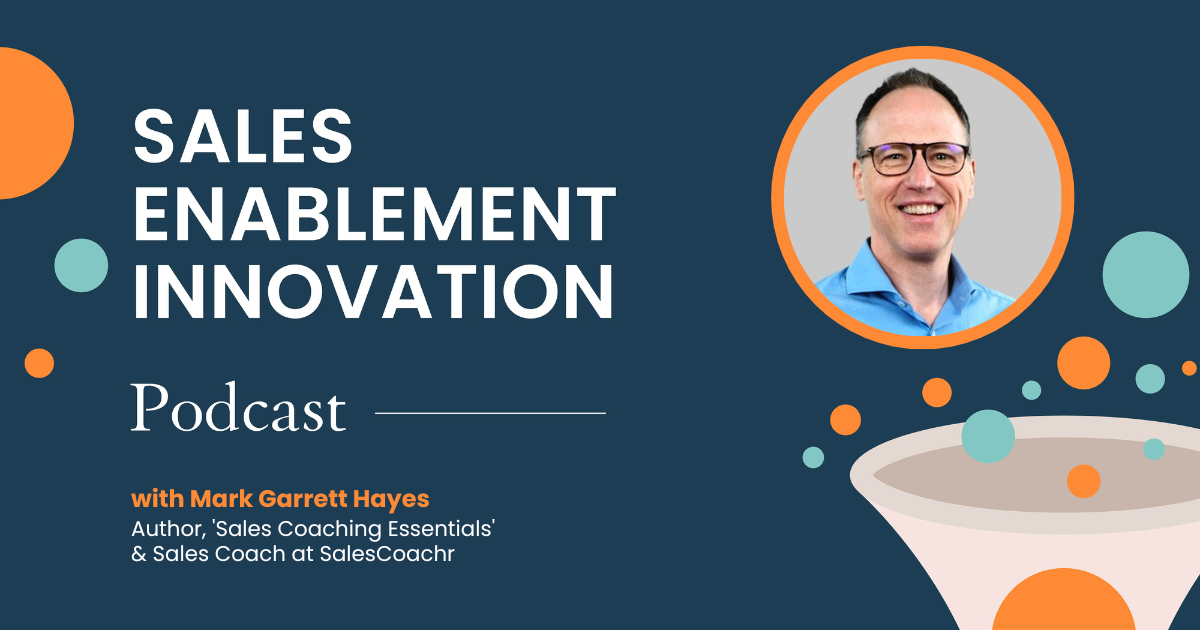What is sales enablement?
Sales enablement is the strategic, ongoing process of equipping sales teams with the content, guidance, and training they need to sell more effectively.
The field of B2B sales has undergone significant changes - customers are more knowledgeable about the products and services they buy. Research suggests that B2B buyers engage with salespeople when they are already 60% through their buying journey.
Sales enablement trains salespeople to deal with these modern world customers.
- It creates a learning culture within the organisation that prompts salespeople to resort to learning if they are stuck with challenges in their job.
- It helps the sales team members to get up to speed about the organisation's products and services and prepare for roadblocks they come across in the field.
B2B sales is a solution-focused industry, and salespeople are the problem solvers. Sales enablement makes them more confident in solving problems for their customers, and this leads to a better customer experience.
Satisfied customers mean more sales and increased revenue.
SiriusDecisions' research also shows that high-performing organizations encourage and provide continuous learning,
So if you want to enable long-term success among loyal, engaged sellers, you’ve got to create a culture of continuous learning.

Some sales enablement is better than no sales enablement
Now, critics of sales enablement might say: "sales is learned in the field, it can’t be learned in the classroom".
If this was true, colleges and universities would not exist, and we all would've been directly hired by companies so that we get to learn on the job.
No one can deny the value of on-the-job learning.
But, having a strong sales enablement program creates a well-defined sales process that every salesperson in the organisation can follow to make them successful at their job.
Every large and successful organisation like Microsoft, TCS, or IBM, that is a market leader or is within the top 5 players of their industry has an L&D division.
These L&D departments have a very well-structured sales enablement program. Perhaps this is one of the reasons for their success.
Learning is a visible and long-lasting change in behaviour.
Sales enablement focuses on bringing about a change in adults who already have a fixed personality and behaviour.
According to ES Research, between 85% and 90% of sales training has no lasting impact after 120 days.
Every year companies are spending billions of dollars on sales training. Sadly, these billions of dollars are being wasted on limited sales performance impact and only short-term boosts in sales at best.
Training programs can be a disappointment if they don't work right away, or they can be a disappointment months later when results don’t materialize.
In the rest of this blog, I'll talk about 5 common reasons why sales enablement fails and what you can do about it.

Reasons why sales enablement fails
1. Lack of planning
“ Failing to plan is planning to fail” - Alan Lakein
Sales enablement is a time consuming and costly process. It means you are taking the sales team away from their selling time to equip them to sell better on the field.
It not only involves the cost of trainers/ facilitators but also the cost of sales leaders and sales teams' time who are attending the training.
So any enablement which is not thought through and aligned to the company's strategic initiatives, customer success, and skill gaps is bound to fail.
This is why sales enablement needs a lot of planning.
Quite often, I have seen L&D heads reaching out to training companies to conduct one of the training sessions for their teams so they could meet their KRA/KPIs.
This approach is better than having no training at all - but, this has very little impact on the skill development of the sales team.
Like any other strategic initiative, if sales enablement is not planned like a major strategic decision, it might lead to failure.
The planning process of sales enablement requires a lot of brainstorming, strategizing and most importantly, discussions with the sales team.
While planning, these parameters should be considered:
- Who are the key stakeholders?
- Is the training aligned to business goals?
- How are you going to ensure post-training reinforcement?
- How is the training effectiveness measured?
- How is the learning journey mapped for the Sales reps?
Without planning and documented strategy, sales enablement ends up being an employee engagement and motivational activity. This yields a very low ROI on overall investment.

2. A lack of reinforcement
Do you remember, when we were kids, that our school teachers used to put more emphasis on revising?
Do you know why?
To make sure that we don't forget what we learn.
A study shows that 80% of information is forgotten in the first 2 days post-training.
How do you ensure your sales team doesn't forget what they have learnt? How do you ensure that they continue to apply the learning daily?
Below are a few steps you can follow for reinforcement of learning :
1. Microlearning:
Microlearning is a way of providing short, focused pieces of content to learners. These are provided ideally where and when they need it.
Content can take many forms. It can be text or full-blown interactive multimedia, but it should always be short.
Here are some microlearning content examples:
- Text (phrases, short paragraphs)
- Images (photos, illustrations)
- Videos (of the short variety)
- Audio (short snippets of speech or music)
- Tests and Quizzes
- Games (e.g. simple single-screen challenges)

2. Gamification:
Games and contests are a great way to reinforce content and drive engagement post-sales training. When you do this, you encourage participants to increase their knowledge retention.
Moreover, this also makes learning fun and helps trainers build social camaraderie with the team.
Gamification of training also allows you to create a leaderboard, which can inspire the team members to do their best to score a position on the leaderboard.
3. Coaching:
Sales coaching is the process of developing and mentoring a salesperson through individualized teaching. Coaching is usually done by managers to help improve the salesperson's performance.
In a recent study conducted by Selling Power, Sales Management Research Report: 5 Hallmarks of High-Impact Sales Organizations, it was found that managers at high-impact sales organizations are more proficient at sales coaching and spend more time coaching their teams than managers at average and low performing sales organizations.
Sales coaching allows the sales managers to instil the learnings from sales training into the daily behaviour of reps.
This promotes a learning culture in the organization, and also helps build a strong focus on reinforcement of learning.

3. Sales enablement should be driven from top to bottom:
Many organisations have an L&D team who are facilitators for sales enablement programs. But, the success of the sales enablement program is actually a joint ownership between sales leadership and the L & D team.
1. Sales leaders are role models
Before I move on to talking about the importance of this point, let me give you a small analogy.
Little kids, when growing up, mostly aim to be like their parents. Parents are usually role models to their kids, and they do their best to inculcate the right values in their children.
For example, as a parent, you must advise your kids to not eat too much junk food. But, if the parents themselves eat junk food in front of their kids, while telling them not to do so, they would just be seen as hypocritical.
They'll follow their parents’ orders for the sake it, or just as long as they are in front of their parents.
They do not actually internalize any values from this.
Salespeople similarly have role models, and more than often it is their sales leaders. We tend to copy what our role models do.
In my opinion, best practice is when sales leaders themselves exhibit the kind of learning that they want their subordinates to follow.
When they do so, their team tries to follow that activity on a day-to-day basis instead of thinking of it as a one-time thing.
When sales leaders do not walk the talk, their subordinates won't take the sales leader’s teachings seriously.

Organizations conduct enablement because they believe that this process could increase their salespeople's efficiency and add to their sales productivity.
This is the reason why salespeople should undergo the process of sales enablement to gain a major takeaway from it.
Sales leaders as role models should encourage this behaviour in the salespeople. If not, salespeople tend to take it as compliance and undergo the process just for the sake of following their superior’s orders.
Moreover, when sales leaders do not practice what they preach, chances are they would be understood to be hypocritical by the team working under them.
2. Reviewing is important.
If sales leaders don't review whether the learnings are applied, it won't be taken seriously
Apart from displaying the learnings themselves, sales leaders must also review these learnings.
This review could be done in two ways:
1. Reviewing the sales quota:
Leaders take note of the sales teams' goals and how efficiently they are fulfilling them after the enablement process.
2. Reviewing the activity:
Leaders ensure that the enablement process includes the activities that can benefit the salesperson and increase their efficiency. If the enablement does not consist of the activities that are actually fruitful for the organization, it just becomes an employee engagement activity that could not impact the business in any way.

Conclusion:
I have written a quote...
“Learners are Earners”
A high performing sales team is always focused on learning and the continuous upgrading of their skills. This is true, no doubt about it.
But, learning is not a silver bullet that can solve all sales-related problems.
Sales enablement is a catalyst in improving sales performance for organisations that have introduced informal sales enablement programs for their sales team. Sales enablement should be treated as a journey.
It's dynamic and changes as per market demands. It may not have immediate returns. But, when done well, in the long term it certainly yields multi-fold rewards.
If you liked this article, share it with others who might find it interesting. If you have any questions, ask them in the comments section. I am always happy to help.
Thank you!
Prabodh is Senior Sales Manager Oracle CX | BFSI | West at Oracle, and first shared this article on LinkedIn here.




